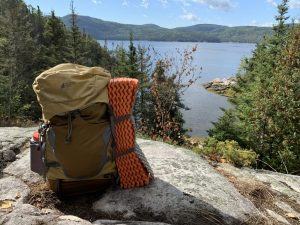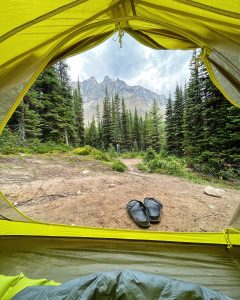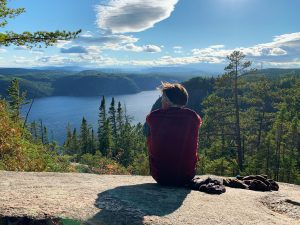11. Plan Ahead and Prepare
- Knowing the rules, access rights, restrictions in effect, and specifics of the site.
- Preparing for bad weather, natural hazards and other emergencies.
- Planning trips during low-traffic periods.
- Exploring less frequented areas. Dividing large groups and go out in smaller groups of 4 to 6 people.
- Bringing a compass and an up-to-date map.
- Repackaging food in reusable containers to minimize waste.

22. Travel And Camp On Durable Surfaces
- Travel and camp on existing trails and campsites.
- For off-trail travel, stay on durable surfaces: bare ground, rock, sand, dry grass, deep snow.
- Avoid altering a site to camp: a good site is found, not made.
- Protect shorelines by camping more than 60 m from lakes and streams.
- In frequented areas:
- Use designated trails and campsites.
- Walk in single file down the middle of the trail, even if it is muddy or wet.
- Limit the camping area. Concentrate your activities on areas without vegetation.
- In pristine, remote or isolated areas:
- Disperse its impact so as not to create new trails or campsites.
- Avoid damaging surfaces that have suffered little or no impact.

33. Dispose Of Waste Properly
- Bringing back waste that was carried in. Separating regular waste from hazardous waste. Burning waste in a campfire is not an acceptable solution.
- Thoroughly inspecting picnic areas and campsites for trash, food scraps, cigarette butts and other micro-waste.
- Depositing human feces in a hole dug more than 60 m (or about 70 adult footsteps) from water sources, trails and campsites. Digging the sanitary hole in organic soil 15 to 20 cm deep and digging and camouflaging after each use.
- Packing-out the toilet paper or put it in the sanitary hole.
- Bathing and washing dishes more than 60 m away from waterways. Using a minimum amount of biodegradable soap.
- Spreading soiled water in large streams through vegetation.
- Filtering food debris through a sieve and placing it with the waste to be packed-out before spreading the dishwater.

44. Leave What You Find
- Preserving heritage: avoid moving or destroying traditional, historical and cultural elements and sites.
- Leaving stones, plants and all other natural objects in their original place and condition.
- Avoid building structures, constructing furniture or digging trenches.
- Preventing the spread of exotic invasive species by removing mud and debris from shoes, clothing and equipment.

55. Minimize Campfire Impacts
- Campfires can cause lasting impacts: opting for cooking on a portable stove is a good solution.
- Placing barbecues, fire boxes and portable stoves on durable surfaces.
- Protecting soil and roots from burning.
- If open fires are allowed, using designated locations. Keeping fires small.
- If wood collection is allowed, burning only dead wood that is collected from the ground and can be broken up by hand.
- Allowing pieces of wood and embers to reduce to ash. Completely extinguishing fires and check that ashes are cool before leaving the area.

66. Respect Wildlife
- Leaving the field clear for the animals and observing them from a distance.
- Moving away at the first sign of nervousness or change in behavior.
- Refraining from feeding animals to avoid harming their health, altering their behavior, or exposing them to predators or other hazards.
- Storing food, garbage and other odorous products in a bear-proof barrel, in facilities provided on site, or in car trunks.
- Avoid disturbing animals during sensitive breeding, nesting and calf rearing periods, or during winter.
- Keeping control of a pet or leave it safely at home. Picking up after our dog or burying it in a sanitary hole.

77. Be Considerate of Others
- Acting with courtesy. On a narrow trail, give way to uphill hikers.
- Pulling over along the trail to give priority to people with mobility aids.
- Taking breaks on durable surfaces off the trail.
- Giving freedom for the sounds of nature to be heard. Avoid excessive noise. Wearing headphones if using electronic devices.
- Limiting the use of drones to areas where they are permitted and following the rules.
- On social networks, posting photos that demonstrate behavior to better protect natural environments.

© 1999 by the Leave No Trace Center for Outdoor Ethics: www.LNT.org.

